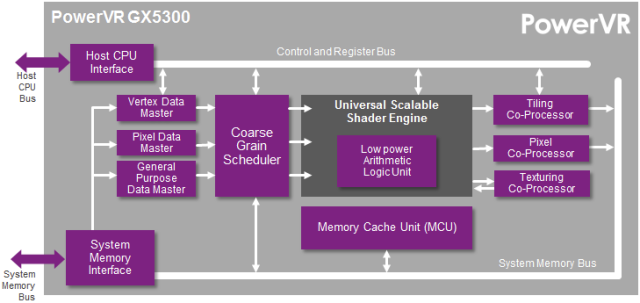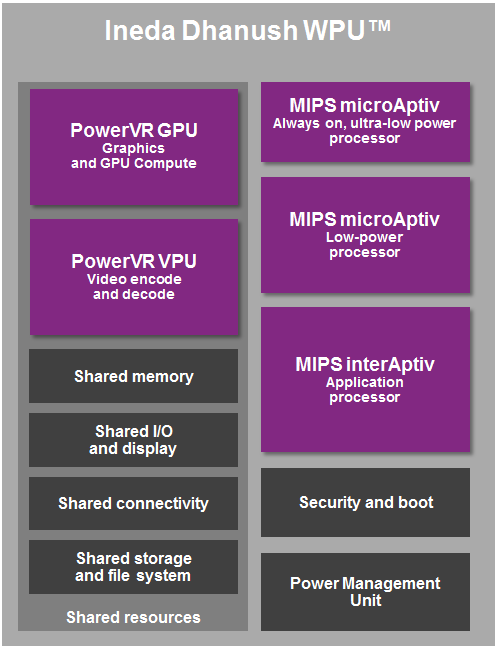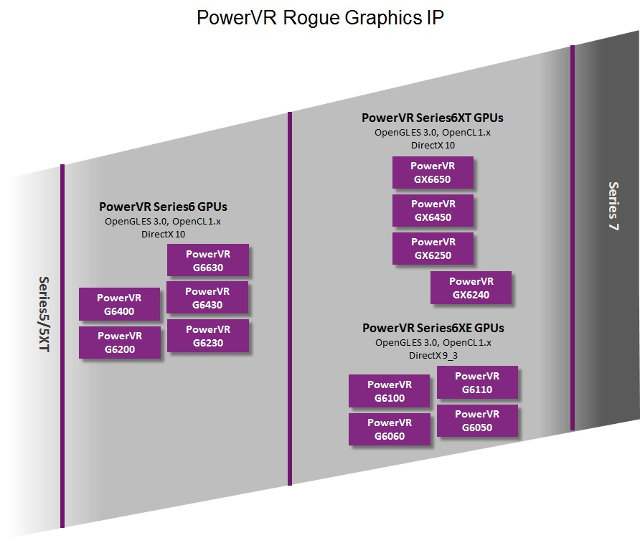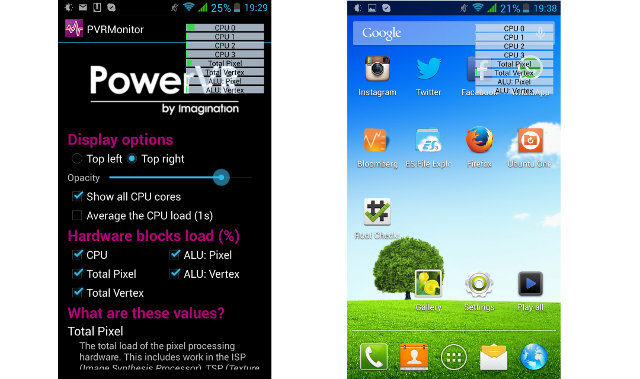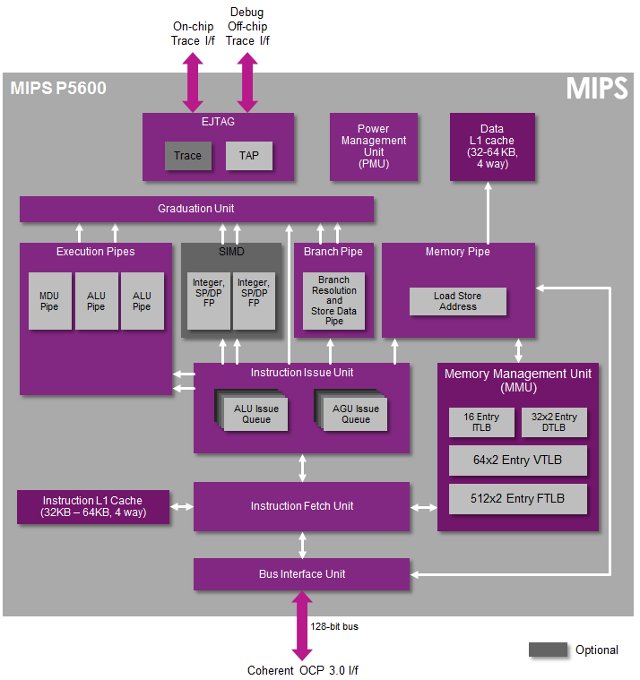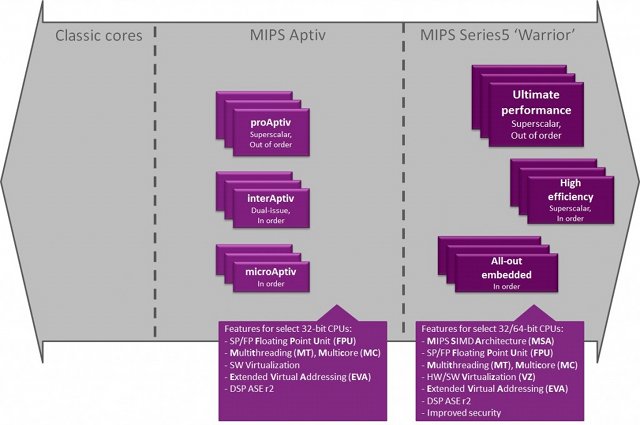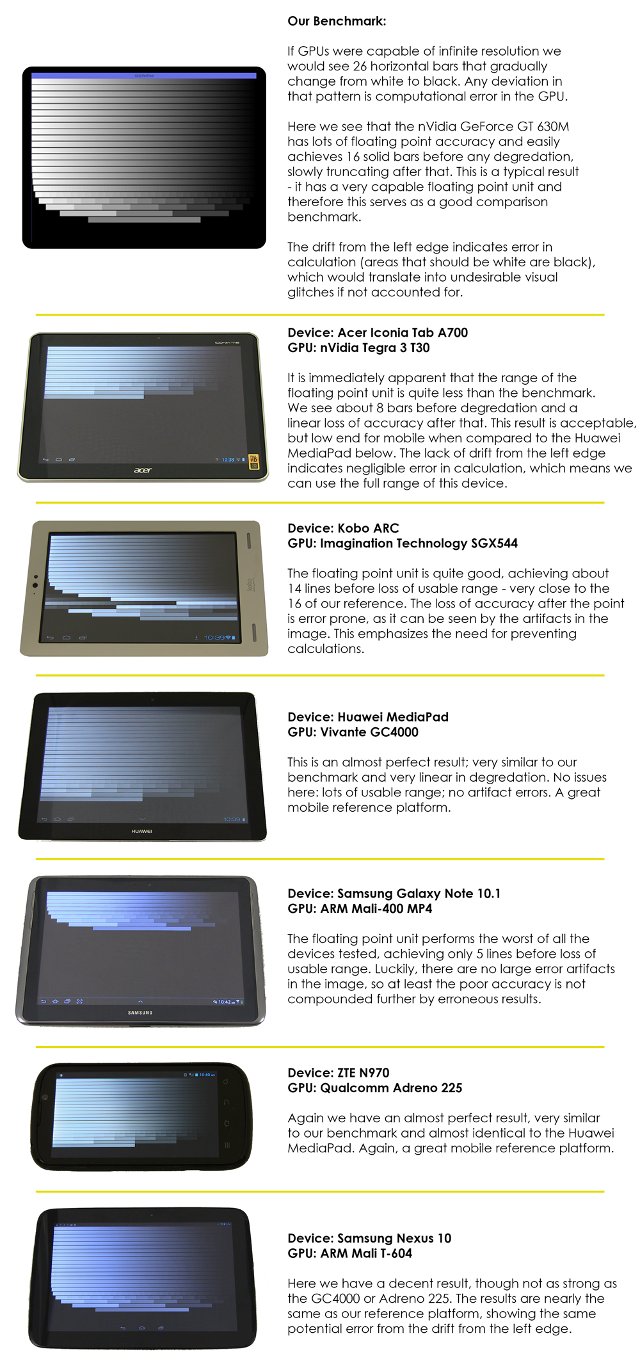Up to now most wearables are based on MCU solutions or derived from mobile platforms, which may either not provide the advanced features required by users, or consume too much power and take more space than needed. With Ineda Dhanush and Mediatek Aster, we’ve already seen silicon vendors design wearables SoCs, and now Imagination Technologies has just announced PowerVR GX5300 GPU targeting wearables with support for OpenGL ES 2.0, 480p to 720p resolution, and using 0.55mm2 silicon area based on 28nm process. PowerVR GX5300 GPU will be support Android, Android Wear, and Linux based operation systems, and according to the company has the following key features: Unified shaders – The TBDR graphics architecture offers unified shaders where vertex, pixel and GPU compute resources are scaled simultaneously. Low power and high precision graphics – All PowerVR GPUs offer a mix of low (FP16) and high precision (FP32) rendering and implement the […]
Ineda Systems Dhanush WPU is a MIPS based SoC Specifically Designed for Wearables
What’s a WPU? It stands for Wearable Processor Unit, and as you may guess it’s a processor specifically designed to be used in wearables such as smartwatches or fitness trackers. Currently, many wearables are based on application processors that are used in smartphones (e.g. Galaxy Gear), and lower-end versions are based on standard low power MCUs (e.g. Pebble), but none of them are actually based on SoC specifically designed for wearables, and analysts are asserting that new types of SoC are definitely needed if companies are to provide wearables with the battery life and features consumers want. Ineda Systems Dhanush WPU is not the first Wearable SoC announced, as for instance AllWinner mentioned their WX quad-core SoC for Wearables should become available in Q4 2014 in their roadmap, and Mediatek vaguely unveiled their Aster SoC at CES 2014, but it’s the first that I know of where we’ve got most of the […]
Prpl Non-Profit Organization to Work on Linux, Android, and OpenWRT for MIPS based Processors
In what looks like an answer, albeit fairly late, to Linaro, the non-profit organization working on open source software for ARM based SoCs, a consortium of companies composed of Imagination Technologies, Broadcom, Cavium, Lantiq, Qualcomm, Ingenic, and a few others, has funded Prpl (pronounced Purple), “an open-source, community-driven, collaborative, non-profit foundation targeting and supporting the MIPS architecture—and open to others—with a focus on enabling next-generation datacenter-to-device portable software and virtualized architectures”. The Prpl foundation will focus on three key objectives: Portability – To create ISA agnostic software for rapid deployment across multiple architecture Virtualization & security – To enable multi-tenant, secure, software, environments in datacenter, networking & storage, home, mobile and embedded Heterogeneous Computing – To leverage compute resources enabling next generation big data analytics and mining Initially there will PEG (Prpl Engineering Group) to take of the following projects for 4 market segments (datacenter, network & storage, connected consumers, […]
Imagination Unveils OpenGL ES 3.0 Compliant Entry Level PowerVR Series6XE GPUs, and Series6XT Architecture Promising TFLOPS Performance
Imagination Technologies has announced four OpenGL ES 3.0 compliant mobile GPUs based on PowerVR Series6XE Rogue architecture for entry level ($100) smartphones, tablets, and other low-end consumer devices such as wearables and smart TVs, as well as four high-end GPUs based on PowerVR Series6XT Rogue architecture capable of TeraFLOPS computing power. PowerVR Series6XE GPUs The new PowerVR Rogue GPUs will deliver the same fillrate performance as equivalent Series5XT multi-processor configurations but offer more in terms of features and functionality, including OpenGL ES 3.0, OpenCL 1.x, and DirectX 9.3. Four entry-level GPUs have been introduced at CES 2014: PowerVR G6050 – Smallest fully-featured GPU core by Imagination with support for OpenGL ES3.0 and OpenCL 1.x. PowerVR G6060 – Same as G6050, but adds PVRIC2, the company’s second generation lossless PowerVR Image Compression. It reduces bandwidth requirements, and it likely to be used in entry-level tablets, HD TVs and STBs. PowerVR G6100 […]
PVRMonitor Displays real-time CPU and GPU performance for PowerVR enabled Android Devices
Imagination Technologies has some advanced tools such as PowerVRTune in their Powervr Graphics SDK, but they’ve now released a simple tool called PVRMonitor to display real-time CPU and GPU usage for Android devices featuring PowerVR GPUs. In some firmware, Android’s Developer Settings have options to enable CPU and GPU usage, but in my phone for example, this is not available, so this app may be handy to check whether your system or app is taking too many resources. Inside the application, you can select the overlay position, whether to show all CPU cores with CPU load averaged over 200ms, or over one second. You can select five hardware blocks to display: CPU Total Pixel – Load in percent of the pixel processing hardware including texturing, raster operation and fragment shader processing. If nothing is modified on the screen it should be zero, and if it is too high during games […]
Imagination Technologies Announced MIPS P5600, the First “Warrior” Core
At the end of June, Imagination Technologies unveiled their MIPS Series5 ‘Warrior’ architecture, featuring 32-bit and 64-bit CPU cores, with features such as hardware and software virtualization, and Extended Virtual Addressing (EVA). The company has recently announced the first member of the family with their MIPS P5600 CPU IP core. The MIPS P5600 core is a 32-bit CPU IP that is said to offer 1.2 to 2x more system performance compared to proAptiv cores, and it supports peak frequencies above 2GHz on TSMC’s 28HPM process node. Performance-wise the core achieves 5 CoreMark/MHz and 3.5 DMIPS/MHz for a single core, which appears to be equivalent to ARM Cortex A15 according to values listed in Wikipedia and EEMBC Coremark results. MIPS P5600 features and benefits: 32-bit MIPS32 Release 5 Instruction Set Architecture 16-stage, wide issue, out-of-order (OoO) pipeline Quad instruction fetch per cycle Triple bonded dispatch per cycle Instruction peak issue of […]
Imagination Technologies Unveils MIPS “Warrior” 32 and 64 Bit CPU Cores
Last year, MIPS announced Aptiv Cores, but since then, the company has been bought by Imagination Technologies, and they’ve recently announced updates to the family, as well as new MIPS Series5 ‘Warrior’ CPU cores during Imagination Summit in Asia. Before I write about the update to Aptiv cores, let me remind you of the 3 Aptiv families: proAptiv – High performance cores (3.5DMIPS/Mhz) to be used in SoC for smartphone, tablets, …. 1 to 6 cores. Roughly equivalent to ARM Cortex A15. interAptiv – Medium performance core (1.7DMIPS/MHz) for mainstream STB, digital cameras, mid-range smartphones. 1 to 4 cores. Equivalent to ARM Cortex A5 microAptiv – Low power MCU and MPU cores Imagination has added a small-footprint single-core version to the interAptiv family without the extra logic associated with multi-core coherency and L2 cache controller, as well as a floating point version to the microAptiv family for applications such as […]
Vivante GC4000 is The Best Mobile GPU… When It Comes to Accuracy
Most of the time, mobile GPU comparisons involve benchmarks such as Antutu, Nenamark 2, etc…, or people may consider which games will be able to run smoothly with a particular device, but we seldom compare image quality, for the simple reason it’s usually more difficult to achieve. YOUi Labs has just done that, however, by running the shader code below on several hardware platforms, mainly Android tablets, with the most common mobile GPUs, and used the results obtained with a Desktop PC GPU, Nvidia Geforce GT 630M, has a reference.
|
1 2 3 4 5 6 7 8 9 10 11 12 13 14 |
precision highp float; uniform vec2 resolution; void main( void ) { float x = ( 1.0 – ( gl_FragCoord.x / resolution.x )); float y = ( gl_FragCoord.y / resolution.y ) * 26.0; float yp = pow( 2.0, floor(y) ); float fade = fract( yp + fract(x) ); if(fract(y) < 0.9) gl_FragColor = vec4( vec3( fade ), 1.0 ); else gl_FragColor = vec4( 0.0 ); } |
Here are the results: The worst GPUs are Mali-400 MP4 in Exynos 4412 and Geforce ULP in Tegra 3, which can respectively only show 5 and 8 lines before degradation, and the top two GPUs are Qualcomm Adreno 225 in MSM8660A, and Vivante GC4000 in HiSilicon K3V2 processor. Imagination Technologies SGX544 and ARM Mali-T604 also provide decent results, but […]


